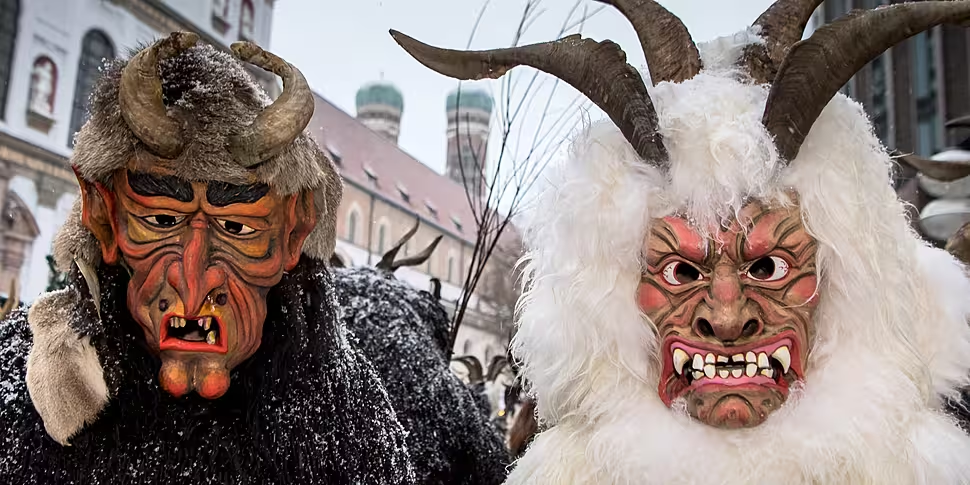It's that time of year again - the time when we look at how other countries celebrate Christmas in weird and wonderful ways.
So sit back, relax and prepare to be a little shocked.
South Africa
Turkey, potatoes and caterpillars.
Here fried caterpillars are considered a delicacy.
The Pine Emperor Moth is one of the largest in Southern Africa, but it is the caterpillars that are especially impressive.
Reaching up to 12cm in length and almost 2cm in diameter, they are covered with a series of colourful spots that almost look like Christmas lights.
 Ian Lindsay from Pixabay
Ian Lindsay from PixabayThis is why they are sometimes referred to as 'Christmas Caterpillars'.
But actually their association with the holiday season is more sinister: they can be a serious pest for pine plantations.
And you thought Brussels sprouts were bad?
Greenland
Another traditional and unusual Christmas delicacy takes us to Greenland.
Children there tuck into mattak, which is raw whale skin with a little blubber.
There is also kiviak, which is made by wrapping a small arctic bird in seal skin and burying it for several months. Then they eat its flesh.
Cheers!
Japan
Perhaps a more palatable - but nevertheless unusual - option takes us to Japan.
A traditional Christmas dinner here is actually a KFC.
Thanks to a successful advertising campaign, families will queue around the block to pick up their battered thighs and wings.
 View of a branch of the fast food chain KFC in Germany. Picture by: Rolf Vennenbernd/DPA/PA Images
View of a branch of the fast food chain KFC in Germany. Picture by: Rolf Vennenbernd/DPA/PA ImagesIt has now become so popular that orders for the KFC Christmas Party Barrel are taken as early as October.
In the run-up to Christmas, Colonel Sanders statues outside Japanese outlets have also been known to wear Santa gear.
And perhaps an important aspect this year is that people can order it online and have it delivered.
Poland
A bit closer to home and this Polish delicacy is arguably its most famous and simple comfort food.
Perogis can be cooked or fried and stuffed, with pretty much anything and everything.
Meat, vegetables, mushrooms, cheese and even fruit and chocolate.
They can also have a sour cream topping or just butter.
Sign me up.
Sweden
The Gävle Goat or 'Gävlebocken' is a traditional Christmas display constructed every year at Slottstorget in the centre of the town of Gävle to the north of Stockholm.
Each year the 40-foot-tall goat it is constructed in the town's central square and has a grand celebration for its unveiling on November 30th.
View this post on Instagram
Over the years, the goat has become famous for being constantly destroyed in arson attacks during December.
Back in 2016, the goat only lasted a matter of hours before falling victim to the flames.
In the past it has also been hit by cars, attacked by a Gingerbread Man, and almost stolen with a helicopter.
Austria
While Irish children are well familiar with Santa’s elves and trusty team of reindeer, children in Austria are dealing with Saint Nicholas' terrifying evil companion - The Krampus.
A horned, folkloric figure described as 'half-goat, half-demon' during the Christmas season, the Krampus travels with Saint Nicholas.
While his big red friend is rewarding the well-behaved with gifts, the Krampus is left to punish those who have been naughty.
 People wearing masks during the traditional Krampuslauf ('Krampus run') at a Christmas market in Munich, Germany in 2017. Picture by: Peter Kneffel/DPA/PA Images
People wearing masks during the traditional Krampuslauf ('Krampus run') at a Christmas market in Munich, Germany in 2017. Picture by: Peter Kneffel/DPA/PA ImagesEach year, thousands of people gather in Hollabrunn Market Square to watch more than 120 Krampus impersonators take to the streets.
Germanic folklore holds that that the Krampus beats naughty children with a bundle of sticks before putting them in a woven wicker basket on his back.
That bag of coal suddenly sounds a lot more reasonable.
Venezuela
Each year between December 16th and 24th, the people of Caracas lace up their roller skates and skate through the streets of the capital for early morning mass.
Streets are closed to traffic until 8.00am to allow for the safe passage of the skaters.
In some areas, children even tie a string to their big toe before they go to sleep and hang it out the window - and passing skaters will give the strings a tug to let them know Christmas has begun.
 Image by Thorsten Frenzel from Pixabay
Image by Thorsten Frenzel from PixabayUkraine
In Ukraine, families decorate their Christmas trees with artificial spider webs - while finding an eight-legged friend (real or fake) on a web is considered good luck.
This tradition comes from Ukraine's Legend of the Christmas Spider - the Pavuchky, literally 'little spider' - and is widely regarded as the origin of the tradition of decorating with tinsel.
In Eastern European folklore, the tradition comes from the story of a poor family who could not afford to decorate their Christmas tree.
While the children were sleeping on Christmas Eve, a spider came down and covered the tree in cobwebs.
When the children opened the windows on Christmas morning they were overjoyed to see the sunlight turning the cobwebs into strands of gold and silver.









